Cisco By The Bay: 10 Scenes From Cisco Live 2014 In San Francisco
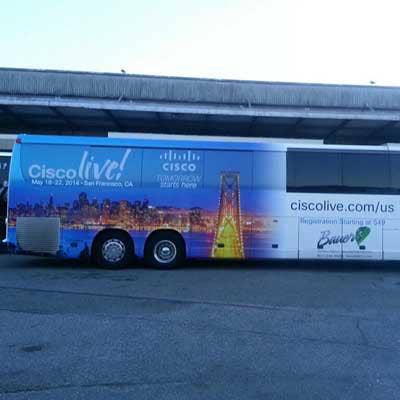
Welcome To Cisco Live
More than 25,000 Cisco customers, partners and users descended on San Francisco last week to attend Cisco Live, the San Jose, Calif.-based networking king's largest event of the year.
And large it was. A packed Moscone Convention Center housed more than 600 different breakout sessions, massive keynote rooms and the sprawling World of Solutions, where attendees flocked for hands-on time with Cisco's latest-and-greatest technology.
Here are 10 scenes recapping the action of Cisco Live 2014.
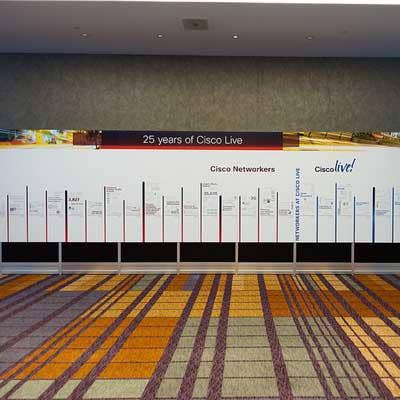
Happy 25th
This year marked the 25th anniversary of Cisco Live, which debuted in 1989 as the Cisco Networkers event.
In addition to the 25,000 on-site attendees, Cisco said this year's event pulled in more than 200,000 online -- a new record for each.
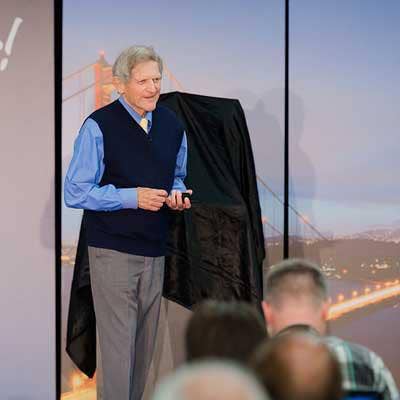
A Bit Of History
Cisco's Chairman Emeritus and former CEO John Morgridge kicked off Cisco Live by giving an overview of the early days of the company, starting with its founding by two Stanford University employees in 1984.
Morgridge joined Cisco in 1988 as president and CEO, a post he held until 1995, when current Cisco CEO John Chambers took to the helm. During his seven-year run, Morgridge grew Cisco from $5 million to more than $1 billion in sales and from 34 to more than 2,250 employees. In 1990, he took Cisco public.
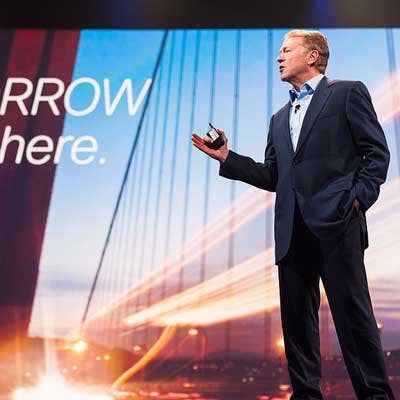
Chambers Talks IoE
Chambers himself took to the stage at Cisco Live to talk about the massive opportunity Cisco sees in the emerging Internet of Everything (IoE).
The 19-year Cisco CEO also spoke about the "brutal" consolidation he expects to see among major IT vendors over the next five years and why he believes Cisco, given its track record in managing market transitions, will come out on top.
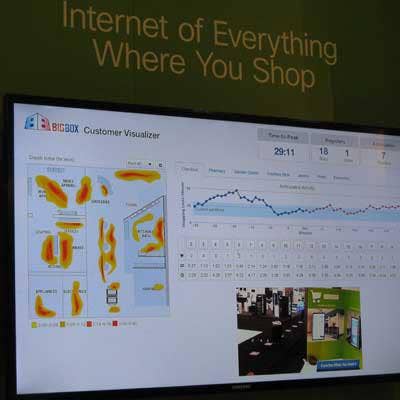
IoE In Action
The World of Solutions at Cisco Live this year housed more than 200 different products from Cisco partners around the globe.
But what it also showcased this year was a number of Cisco's own technologies for fueling the Internet of Everything, a growing network of everyday "things" that are being connected to the Internet to communicate with themselves and the people around them.
Among the Cisco-powered IoE solutions on display was an application retail stores can use to track the flow of customers throughout their shops. The technology works by sensing where shoppers are based on the smartphone or other mobile device they (likely) have in their pockets. Store managers can then view that information as a heat map to tell, for instance, which parts of the shop floor might require more staff.
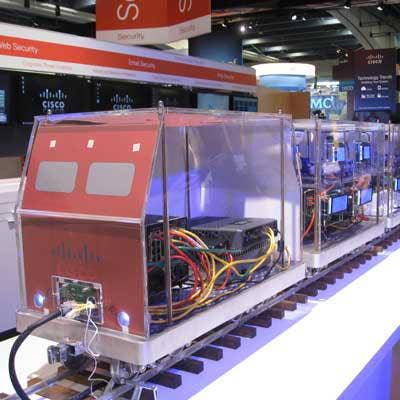
The IoE Train
One of the standout items in the World of Solutions was a prototype of an IoE-enabled train, equipped with a number of Cisco industrialized switches, machine-to-machine routers and its ruggedized security cameras.
Cisco said these trains of the future will leverage IoE technologies to make things easier for passengers and train staff alike. A passenger information systems could be used, for example, to display to passengers how many seats are free in each direction of the train. Surveillance cameras, meanwhile, can be used to live-stream footage from each car to a conductor's iPad or tablet.
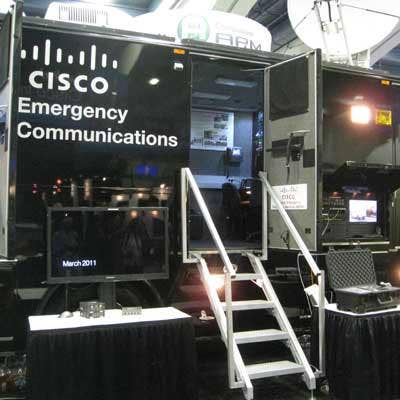
Cisco Emergency Response Vehicle
Another hard-to-miss item in the World of Solutions was Cisco's Network Emergency Response Vehicle (NERV), a mobile communications center for natural disasters or other emergency situations.
Created in 2007, NERV is basically a command and connectivity hub on wheels. It's designed to ensure first responders have access to communications technology even when local infrastructures have been destroyed. Cisco said NERV can be fully operational in 15 minutes, providing a wireless connection, VoIP, network-based videosurveillance and a full suite of telephony services through the Cisco Unified Communications Manager Express software.
The first emergency deployment of NERV was in late 2007, during the Harris fires in San Diego County, Calif.
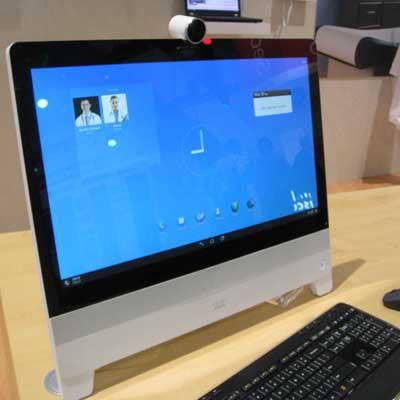
Cisco DX80
Cisco unveiled a number of new collaboration devices at Cisco Live this year, but chief among them was the new DX80 endpoint.
Designed to be a one-stop shop for desktop collaboration, the DX80 looks like a tablet, but serves as a monitor, a desk phone and a videoconferencing unit in one. Cisco said it created the DX80 to help eliminate all the desktop "clutter" caused by workers having to separately use a phone, a monitor, a webcam and other gadgets to connect via video.
The 23-inch DX80 is touch-enabled and runs Google's Android operating system. In addition to the apps available via Google Play, the devices come with Cisco WebEx, Cisco Jabber, Cisco Communications Manager and Cisco phone features, such as call transfer, voicemail, etc., built in.
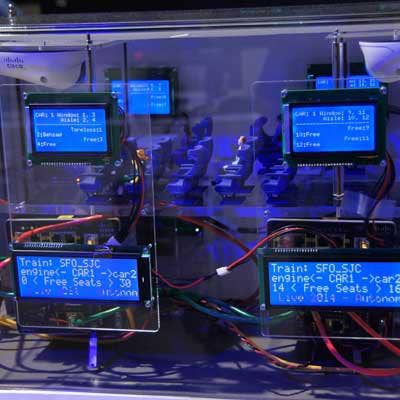
Submerged Switch
Cisco last week said it's developed more than 700 products to fuel the Internet of Everything. Many of them, like the switch shown here, are what Cisco calls "ruggedized," or designed to withstand harsh temperatures and environments.
This particular switch can be submerged under water, Cisco said, making it ideal for vertical markets like manufacturing.
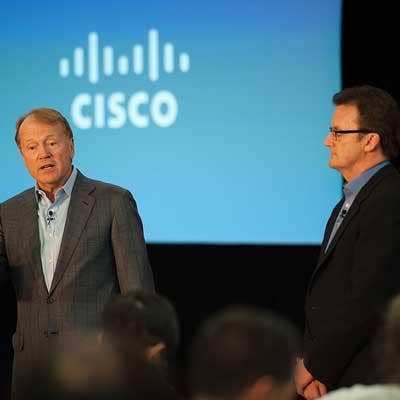
Q&A Time
Chambers and Cisco President of Development and Sales Rob Lloyd spent time with reporters to field some tough questions about whether Cisco would really acquire Rackspace, how Cisco feels about the NSA revelations, and who might be next in line for the CEO seat.
"It'll be a reasonably short transition to hand the baton to the new CEO," Chambers said. "But it's kind of like [being] a parent: Your legacy is your kids. You want your kids to be successful and happy. I want the next generation of leaders to do exactly what the generation before them has done at Cisco, which is to be very successful."
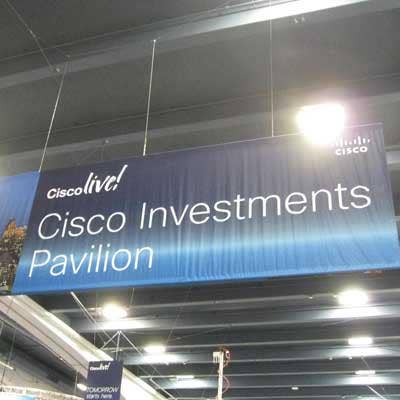
Cisco Investments Pavilion
To catch a glimpse of some of the early-stage companies Cisco is funding, attendees could visit Cisco's Investments Pavilion.
The pavilion, set inside the World of Solutions, housed 22 Cisco-funded startups, including Pentaho, Bit Stew Systems and Embrane. Most of the companies were showcasing next-generation technologies for big data analytics, connected mobility and the Internet of Everything.
Cisco's Investment arm said in April that it's pumping another $150 million into IoE startups around the globe, bringing its total IoE startup funding to $250 million.